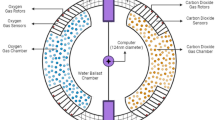Abstract
Nanotechnology deals with molecules in the nanometer (10−9) range and is currently being used successfully in the field of medicine. Nanotechnology has important implications in nearly all the branches of medicine and it has all the capabilities to revolutionize the vast field of medicine in future. Nanotechnological advancements have been used for the preparation of artificial hemoglobin. It is formed by assembling the hemoglobin molecules into a soluble complex. A recent approach includes the assembling of this artificial hemoglobin with enzymes such as catalase and superoxide dismutase into a nano-complex. This complex acts as an oxygen carrier as well as an antioxidant in conditions with ischemia–reperfusion injuries.


Similar content being viewed by others
References
Aggarwal S, Sharma V (2012) Attitudes and problems related to voluntary blood donation in India: a short communication. Ann Trop Med Public Health 5:50–52
Blood safety and clinical technology. Available at-http://www.searo.who.int/en/section10/section17/section1976.htm
Chaitanya kumar IS, Yashoverdhan (2011) Efforts to meet the challenges of 100 % voluntary blood donation. Asian J Transfus Sci 5:68–69
Based on WHO Global Database on Blood Safety (GDBS) 2008, with responses received from 164 countries, covering 92 % of the world’s population. Available at http://www.who.int/bloodsafety/global_database/GDBS_Summary_Report_2011.pdf
Geyer RP, Monroe RG, Taylor K (1968) Survival of rats having red cells totally replaced with emulsified fluorocarbon. Federation Proc 27:384–390
Sloviter H, Kamimoto T (1967) Erythrocyte substitute for perfusion of brain. Nature 216:458–460
Keipert PE (1998) Perfluorochemical emulsions: future alternatives to transfusion. Blood Subst Princ Meth Prod Clin Trials 2:127–156
Spahn DR, Leone BJ, Reves JG, Pasch T (1994) Cardiovascular and coronary physiology of acute isovolemic hemodilution: a review of nonoxygen-carrying and oxygen-carrying solutions. Anesth Analg 78:1000–1021
Riess JG (1992) Overview of progress in the fluorocarbon approach to in vivo oxygen delivery. Biomater Artif Cells Immobil Biotechnol 20:183–202
Lowe KC (1999) Perfluorinated blood substitutes and artificial oxygen carriers. Blood Rev 13:171–184
Riess JG, Krafft MP (1998) Fluorinated materials for in vivo oxygen transport (blood substitutes), diagnosis and drug delivery. Biomaterials 19:1529–1539
Mattrey RF (1994) The potential use of Perflourochemicals (PFC’s) in diagnostic imaging. Artif cells, Blood Substit Immobil Biotechnol 22:295–313
Antonini E, Brunori M (1971) “Kinetics of the reactions of hemoglobin and myoglobin with ligands” Chapter 8 in: hemoglobin and myoglobin in their reactions with ligands. Frontiers of Biol, North-Holland Publishing Company 21:189–217
Ackers GK, Johnson ML (1981) Linked functions in allosteric proteins. J Mol Bio 147:559–582
Benesch R, Benesch RE (1969) Intracellular organic phosphates as regulators of oxygen release by haemoglobin. Nature 221:618–622
Antonini E, Condò SG, Giardina B, Ioppolo C, Bertollini A (1982) The effect of pH and d-glycerate 2,3 bisphosphate on the O2 equilibrium of normal and SH(_93)-modified human haemoglobin. Eur J Biochem 121:325–328
Oto B. Respiration and hemoglobin, EMS basics. Available at: http://emsbasics.com/2011/08/03/respiration-and-hemoglobin/
Kresie L (2001) Artificial blood: an update on current red cell and platelet substitutes. BUMC Proc 14:158–161
Winslow RM (2006) Current status of oxygen carriers (‘blood substitutes’). Vox Sang 91:102–110
Carson JL, Noveck H, Berlin JA, Gould SA (2002) Mortality and morbidity in patients with very low postoperative Hb levels who decline blood transfusion. Transfusion 42:812–818
Chang TMS (1964) Semipermeable microcapsules. Science 146:524
Chang TMS. Artificial cells. Monograph. Charles C Thomas, Springfield, IL, 1972. (full text available at www.artcell.mcgill.ca)
Chang TMS (1971) Stabilisation of enzymes by microencapsulation with a concentrated protein solution or by microencapsulation followed by cross-linking with glutaraldehyde. Biochem Biophys Res Common 44:1531–1536
Chang TMS (2007) Monograph on “ARTIFICIAL CELLS: biotechnology,nanotechnology, blood substitutes, regenerative medicine, bioencapsulation,cell/stem cell therapy”. World Science Publisher, Singapore, p 452. Available at:http://www.medicine.mcgill.ca/artcell/2007%20ebook%20artcell%20web.pdf
Chang TMS. Blood substitutes: principles, methods, products and clinical trials. Vol.1 Basel Karger,1997. (full text and updates available at www.artcell.mcgill.ca)
Gould SA, Moore EE, Hoyt DB, Ness PM, Norris EJ, Carson JL et al (2002) The life-sustaining capacity of human polymerized Hb when red cells might be unavailable. J Am Coll Surg 195:445–452
Pearce LB, Gawryl MS, Rentko VT, Moon-Massat PF, Rausch CW (2006) HBOC-201 (Hb Glutamer-250 (Bovine), Hemopure): clinical studies. In: Winslow R (ed) Blood substitutes. Academic Press, San Diego, pp 437–450
D’Agnillo F, Chang TMS (1998) PolyHb-superoxide dismutase. Catalase as a blood substitute with antioxidant properties. Nat Biotechnol 16:667–671
Chang TMS (1985) Artificial cells with regenerating multienzyme systems. Meth Enzymol 112:195–203
Gu KF, Chang TMS (1988) Conversion of ammonia or urea into l-leucine, l-valine and l-isoleucine using artificial cell immobilising multienzyme system and dextran-NADH+. I. Glucose dehydrogenase for cofactor recycling. J Am Soc Artif Intern Organs 11:24–28
Chang TMS, Powanda D, Yu WP (2003) Ultrathin polyethylene-glycolpolylactide copolymer membrane nanocapsules containing polymerized Hb and enzymes as nano-dimension red blood cell substitutes. Artif Cells Blood Substit Biotechnol 3:231–248
Djordjevich L, Miller IF (1980) Synthetic erythrocytes from lipid encapsulated Hb. Exp Hematol 8:584
Philips WT, Klpper RW, Awasthi VD, Rudolph AS, Cliff R, Kwasiborski VV et al (1999) Polyethylene glyco-modified liposome-encapsulated Hb: a long circulating red cell substitute. J Pharm Exp Therapeutics 288:665–670
Chang TMS (1976) Biodegradable semipermeable microcapsules containing enzymes, hormones, vaccines, and other biologicals. J Bioengineering 1:25–32
Yu WP, Chang TMS (1994) Submicron biodegradable polymer membrane Hb nanocapsules as potential blood substitutes: a preliminary report. Artif Cells Blood Substit Immobil Biotechnol 22:889–894
Yu WP, Chang TMS (1996) Submicron biodegradable polymer membrane Hb nanocapsules as potential blood substitutes. Artif Cells Blood Substit Immobil Biotechnol 24:169–184
Chang TMS, Yu WP, Yu WP (1998) Nanoencapsulation of Hb and RBC enzymes based on nanotechnology and biodegradable polymer. In: Chang TMS (ed) Blood substitutes: principles, methods, products and clinical trials, vol 2. Karger, Basel, pp 216–231
Author information
Authors and Affiliations
Corresponding author
Rights and permissions
About this article
Cite this article
Alam, F., Yadav, N., Ahmad, M. et al. Blood Substitutes: Possibilities with Nanotechnology. Indian J Hematol Blood Transfus 30, 155–162 (2014). https://doi.org/10.1007/s12288-013-0309-5
Received:
Accepted:
Published:
Issue Date:
DOI: https://doi.org/10.1007/s12288-013-0309-5




